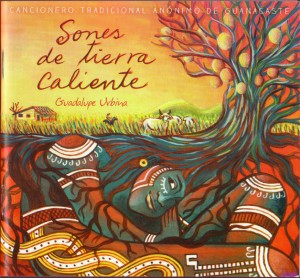Historical Album by Guadalupe Urbina
Born the youngest of ten children in Sardinal, Guanacaste, Guadalupe Urbina demonstrated her interest in folkloric music at a very early age. She sings with passion, veracity, capriciousness and has an incredible range with her voice. She credits her mother as being her mentor and biggest fan as well. Ms. Urbina received her deserved recognition in 1987, when she was invited to participate in the Latin American Music Festival in The Netherlands. From that performance, she was asked to perform at the 1988 Amnesty International Festival in San Jose, along with the likes of Bruce Springsteen, Tracy Chapman, Sting and Peter Gabriel.
Guadalupe has recently released “Sones de Tierra Caliente”, a compilation of sixteen regional songs that have been passed from countless generation to generation. The songs are a mix of lullabies, fiesta songs, romantic songs, children’s songs and street songs, all stemming from the Costa Ricaprovince of Guanacaste. They are so entrenched in time that the songwriters are unknown. She has travelled to an assortment of small villas to gather these songs, traveling west from Sardinal to Artola, Portegolpe and Brasilito, and then south to Santa Barbara, Talolingo, Nambi and Diria. Some of the songs are humorous and some romantic; some are both. Guadalupe credits each person who “donated” the various songs and they are each given the opportunity to introduce their contribution prior to the beginning of the song. Each song is described in its historical detail in an accompanying booklet, the lyrics are printed and the music transcribed. It is really an amazing accomplishment, a true labor of love by Ms. Urbina and all involved, including Luis Porras and Fidel Gamboa who helped score the songs.
The album opens with “El Pilon” and “La Zopilota” two songs about working under the hot sun in the finca, songs recanted by generations of workers in the fields and farmlands. “En Coche Va Una Nina” is nursery rhyme, as are “El Garrobo” and “Chinto Pinto”, sung with a cadence, to accompany hand games or skipping rope, and “Cancion de Cuna” is a lullaby. The remainder are songs of love and humor; sometimes both themes are combined. One of my favorites is “La Viuda Alegre”, sung as a traditional waltz.
Guadalupe gathered an impressive group of musicians to record this compilation. The versatile Ricardo Fonseca played guitar, bass, saxophone, marimba and mandolin and helped arrange the album. Warren Alani supplied nice piano accompaniment. Isaac Morero played various forms of percussion, while Veronica Zumbado played violin, Ivan Chinchilla the trombone and Carlos Valverde the tuba. The musical accompaniment rounds the songs out, makes them more palatable and credible as an historic part of Guanacaste culture. The wonderful, lush painting and graphics are by Mary Anne Ellis.
Truly, Guadalupe Uribe shines on this project; it is her baby. Her voice is expressive, dimensional. Her work here is obviously a labor of love and she is to be commended and thanked for her hard work. The CD is available at the Jaime Peligro book store in Playa Tamarindo and Quepos.


